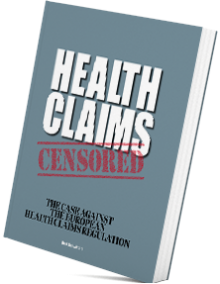During the deliberations that took place in the EU Parliament concerning the renewal of the current Directive that regulates market entry of “novel foods,” special attention was given to foods that are peculiarly defined as both novel and traditional. These foods fall in a category the definition of which combines diametrically opposing criteria. They’re old and new at the same time. Like works of art that are simultaneously mediaeval and modern. Like regulations that simultaneously prohibit and authorize.
How can something be novel and traditional at the same time ? Searching for a definition of the term “traditional” in the novel version of the Novel Food Directive proposed by the European Parliament, we find that “traditional,” as used in the terms “traditional propagating practices” and “traditional breeding practices,” means “used … within the Union before 15 May 1997.” In the European Union, foods produced by way of pre-1997 practices cannot become novel. They remain traditional from 1997 to eternity.
In line with the foregoing, the term “novel,” as used in the definition of “novel food,” means “not used … to a significant degree within the Union before 15 May 1997.” This definition combines a qualification (“used before 15 May 1997”) and a quantification (“used to a significant degree”). Why the definition of “traditional” used to define “traditional propagating or breeding practices” lacks the “significant degree” quantification criterion remains unexplained in the Parliament’s proposal. Pre-1997 food producing practices are considered traditional when they were used somewhere in the Union, irrespective of the volume of the foods produced by this practice.
Anyway, on the 15th of May 1997, “tradition” ended and the era of “novel” foods began, in the European Union.
Where does this leave foods that were produced to an insignificant degree by a propagating/breeding practice that perfectly qualifies as “traditional” ? Such foods do not qualifiy as “traditional,” because their pre-1997 use was “insignificant.” But because they were produced by way of a traditional practice, they can’t be qualified as “novel” either. Irrespective of their potential nutritional, physiological or therapeutic value, they evaporated in the void created by legislators who try to squeeze reality into the mold of their world views.
Where do traditional-and-novel foods come from ? According to the co-legislators, they come from “third countries.” Third countries are found beyond the borders of the European Union. When drawing up a list of such “third countries,” Norway, the United States, Canada, Japan, Argentina, China, Switzerland, Bresil, India and Russia haphazardly come to mind. Food from these and other “third countries” is defined as “traditional food from a third country” when it is “derived from primary production, with a history of safe food use in a third country.” All that is required to redefine such outlandish traditional foods as novel in the European Union is a “history of safe use.”
What matters here is the definition of “safe.” In its proposal for Recital 2 in the new Novel Foods Regulation, the European Parliament explicitly states that the level of safety for novel foods to enter the Union’s internal market shall be the level of safety defined in the Precautionary Principle as laid down in Article 7 of the Regulation 178/2002/EC (EU’s General Food Law). This is the highest level of protection that exists in the European Union. It seeks to protect consumers against unknown and undefined potential risks by demanding absolute proof that harm will not arise in some distant and unqualified future.
What’s more, the Parliament not only seeks to precaution human health and consumers’ interests against potential risks. It also wants to make market entry of novel foods conditional on being in line with the Union’s regulations that protect the interests of the environment and animals. Applying precaution in the field of food and human health, means that activities (“practices”) and goods (“foods”) may be prohibited “in specific circumstances where, following an assessment of available information, the possibility of harmful effects on health is identified but scientific uncertainty persists, … , pending further scientific information for a more comprehensive risk assessment.” In practice, it is up to the “precautionee” to perform such comprehensive risks assessments and demonstrate with scientific certainty the absence of potential risk of harm.
According to both the European Commission and Parliament in their Novel Food proposals, “the placing on the market within the Union of traditional foods from third countries should be facilitated, …” This idea seems to be in line with Article 11 of the European Food Regulation 178/2002, which provides that “[f]ood and feed imported into the Community for placing on the market within the Community shall comply with the relevant requirements of food law or conditions recognised by the Community to be at least equivalent thereto or, where a specific agreement exists between the Community and the exporting country, with requirements contained therein.”
Traditional-novel foods coming from third countries must comply with requirements or conditions “at least equivalent” to those applied to foods produced within the Union, especially where there is no “specific agreement between the Union and the exporting country” in place. When the Precautionary Principle applies as the relevant requirement, the definition of “history of safe use” becomes essentially relevant. How does “history” produce scientific certainty, one might ask.
It took the members of the European Parliament creative juggling with words such as history, tradition, safe, food, experience, customary, diet and significant, to make the “history of safe use” look equivalent to the harsh precautionary safety requirements set for genuinely novel “novel foods.” The Parliament tried to produce the image of equivalence by defining “history of safe food use in a third country” as meaning “that the safety of the food in question has been confirmed with compositional data and from experience of continued use for at least 25 years in the customary diet of a significant number of people in at least one third country as defined in guidelines referred to in Article 4 of this Regulation, […]”
Surprisingly, the Parliament’s proposal for the text of the aforementioned “Article 4 of this Regulation” lacks a definition of “significant number of people.” As usual, the legislators leave it to EFSA to provide the definition of “significant part of the population of a third country.” It is for EFSA to seek out how, in terms of risk assessment, a significant part of the Swiss population (8 million) could match a significant part of the Chinese people (1.355 billion) and how this criterion might produce the “documented data demonstrating the history of safe food use in a third country,” required to authorize a traditional “third country” food as novel in the Union.
It will take quite some wisdom and ingenuity to formulate what kind of comprehensive risk assessment, involving documented data concerning 25 years of use by a significant part of a population in some country, can produce the scientific certainty required in precautioning “the possibility of harmful effects on health.” Less than this isn’t an option, given the fact that the whole idea of regulating novel foods rests on the a priori that all novel foods, including foods that have been legitimately marketed in third countries for more than 25 years, are “guilty unless proven innocent.”
When the European legislature created and enacted the Nutrition and Health Claims Regulation, it omitted to formulate a procedure to facilitate the placing on the market of health claims concerning the traditional use of foods. This omission came to light as problematic in view of that fact that the Union’s regulations concerning medicinal products provide a simple procedure for traditional therapeutic indications.
The simplified procedure foreseen in the new Novel Foods regulation for traditional foods is even “lighter” than the one laid down in the European Medicines Directive. It is also considerably “lighter” than the procedure that must be followed by applicants who intend to place on the market a genuinely novel-novel food, for the authorization of which they must produce “scientific evidence demonstrating that the novel food does not pose a safety risk to human health and where applicable to the environment.”
Applicants who intend to place on the market within the Union a traditional food from a third country, may opt to submit a notification of that intention to the Commission. Proof that the traditional food does not pose a safety risk may consist of “documented data demonstrating the history of safe food use.” The effects on the environment are conveniently omitted in the notification’s requirements.
It would be laudable if the European legislators would treat traditional health claims the way they treat traditional medicinal products and intend to treat traditional foods and traditional food production practices. Traditional health claims deserve a similarly “light” regulatory framework. The conditions of use accompanying these traditional health claims should not be limited to a certain category of foods or ingredients as a way of indirectly restricting the number of traditional health claims that can be authorized. Conditions of use accompanying traditional health claims should be open for all foods.
Bert Schwitters




